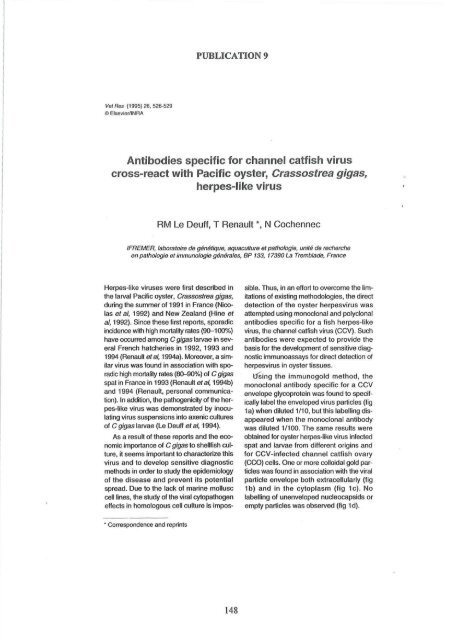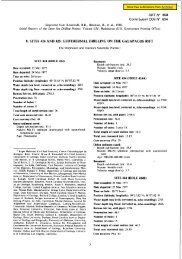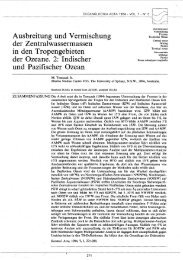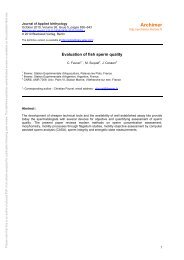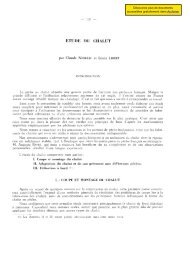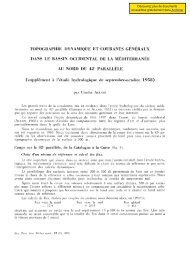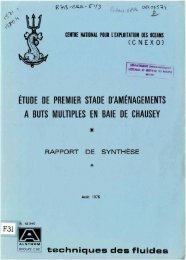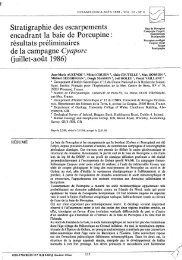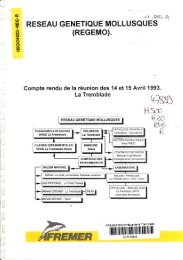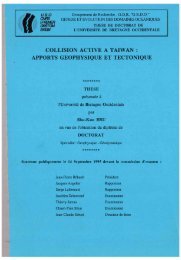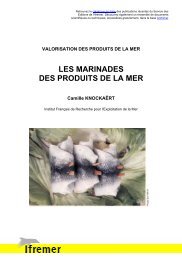Contribution à l'étude de virus de mollusques marins apparentés ...
Contribution à l'étude de virus de mollusques marins apparentés ...
Contribution à l'étude de virus de mollusques marins apparentés ...
Create successful ePaper yourself
Turn your PDF publications into a flip-book with our unique Google optimized e-Paper software.
Vet Res (1995) 26, 526-529<br />
© Elsevier/INRA<br />
PUBLICATION 9<br />
Antibodies specific for channel catfish <strong>virus</strong><br />
cross-react with Pacific oyster, Crassostrea gigas,<br />
herpes-like <strong>virus</strong><br />
RM Le Deuff, T Renault ' , N Cochennec<br />
IFREMER, laboratoire <strong>de</strong> génétique, aquaculture et pathologie, unité <strong>de</strong> recherche<br />
en pathologie et immunologie générales, BP 133, 17390 La Trembla<strong>de</strong>, France<br />
Herpes-like <strong>virus</strong>es were first <strong>de</strong>scribed in<br />
the tarval Pacific oyster, Crassostrea gigas,<br />
during the summer of 1991 in France (Nicolas<br />
et al, 1992) and New Zealand (Hine et<br />
al, 1992). Since these first reports, sporadic<br />
ind<strong>de</strong>nce with high mortality rates (90-100%)<br />
have occurred among C gigas larvae in several<br />
French hatcheries in 1992, 1993 and<br />
1994 (Renault et al, 1994a). Moreover, a similar<br />
<strong>virus</strong> was found in association with sporadic<br />
high mortality rates (80-90%) of C gigas<br />
spat in France in 1993 (Renault et al, 1994b)<br />
and 1994 (Renault, personal communication).<br />
In addition, the pathogenicity of the herpes-like<br />
<strong>virus</strong> was <strong>de</strong>monstrated by inoculating<br />
<strong>virus</strong> suspensions into axenic cultures<br />
of C gigas larvae (Le Deuff et al, 1994).<br />
As a result of these reports and the economic<br />
importance of C gigas to shellfish culture,<br />
it seems important to characterize this<br />
<strong>virus</strong> and ta <strong>de</strong>velop sensitive diagnostic<br />
methods in or<strong>de</strong>r to study the epi<strong>de</strong>miology<br />
of the disease and prevent its potential<br />
spread. Due ta the lack of marine mollusc<br />
œlllines, the study of the viral cytopathogen<br />
effects in homologous cell culture is impos-<br />
• Correspon<strong>de</strong>nce and reprints<br />
148<br />
sible. Thus, in an effort to overcome the limitations<br />
of existing methodologies, the direct<br />
<strong>de</strong>tection of the oyster herpes<strong>virus</strong> was<br />
attempted using monoclonal and polyclonal<br />
antibodies specific for a fish herpes-like<br />
<strong>virus</strong>, the channel catlish <strong>virus</strong> (CCV). Such<br />
antibodies were expected ta provi<strong>de</strong> the<br />
basis for the <strong>de</strong>velopment of sensitive diagnostic<br />
immunoassays for direct <strong>de</strong>tection of<br />
herpes<strong>virus</strong> in oyster tissues.<br />
l1Sing the immunogold method, the<br />
monoclonal antibody specific for a CCV<br />
envelope glycoprotein was found to specifically<br />
label the enveloped <strong>virus</strong> particles (fig<br />
la) when diluted 1110, but this labelling disappeared<br />
wh en the monoclonal antibody<br />
was diluted 11100. The same results were<br />
oblained for oyster herpes-like <strong>virus</strong> infected<br />
spat and larvae from different origins and<br />
for CCV-infected channel catfish ovary<br />
(CCO) œ lls. One or more colloidal gcld particles<br />
was found in association with the viral<br />
particle envelope bath extracellularly (fig<br />
1 b) and in the cytoplasm (fig 1 cl. No<br />
labelling of unenveloped nucleocapsids or<br />
empty particles was observed (fig 1 dl.


